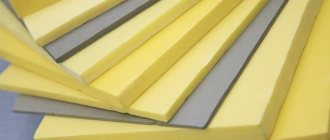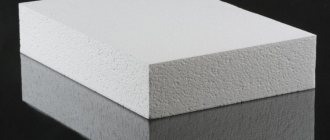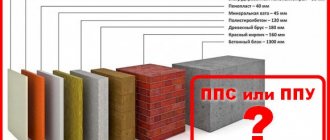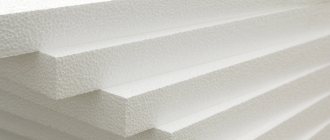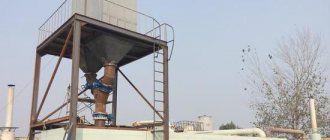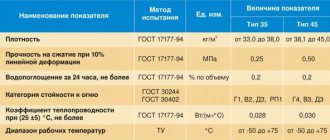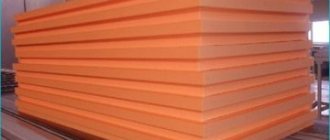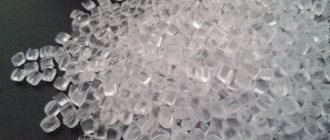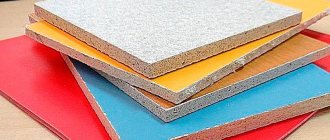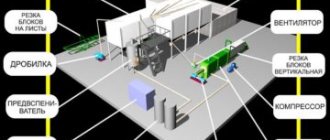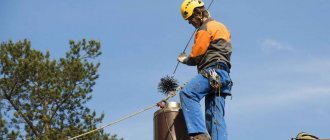Penoplex is a popular construction thermal insulator. It appeared on the market in the early 40s of the last century, it was developed by the American company Dow Chemical as a non-sinking material for watercraft. After World War II, its other properties were appreciated, including low heat conductivity. It began to be used in the construction of frame houses in the USA and Canada. It is made from a semi-finished product - polystyrene foam granules using the extrusion method. Penoplex is in demand due to its light weight, ease of installation and affordable price. But how environmentally friendly and fire-resistant is polystyrene foam?
Flammability and safety of polystyrene foam
Almost all insulation materials, with the exception of stone wool, burn well. Penoplex is no exception; its flammability when it appeared on the market was extremely high. During its production, many modifications were developed; they are flammable to varying degrees. Some manufacturers add non-flammable components to the composition, which melt when exposed to fire. If fire retardants are not used in the material, it burns well. During combustion, carbon dioxide and toxic substances are released from the heat insulator, which can cause damage to human health and the environment. But this harm is comparable to burning wood, MDF, and polymers. But only if the penoplex contains no harmful components.
Important! There is a common belief that when polystyrene foam burns, hydrocyanic acid is released. This is wrong. Most likely, this myth was invented by competitors of the manufacturers of this heat insulator.
“Velit” insulation made of porous concrete D-140
A very good and promising heat insulator, which is used to insulate house facades, flat roofs, floors, and ceilings. What does he imagine himself to be? Velit is porous concrete D-140 (for understanding, I can say that one cubic meter of this material weighs only 140 kg) is non-flammable.
It does not have a flammability class, it is simply not standardized by class, it is NG, which means non-flammable. Since this insulation is porous concrete, in principle it cannot burn, and there is nothing you can add here.
Is there fire retardant foam?
Since the raw materials from which the heat insulator is made burn well, ordinary polystyrene foam has a high flammability class - fourth. It ignites already at +210 degrees C, and immediately after ignition the temperature begins to rise rapidly, and reaches +1200 degrees C. Penoplex contains a lot of carbon dioxide, so combustion is accompanied by copious smoke. Monomers, blowing agent vapors and oxidation by-products are released into the atmosphere. There are several ways to reduce flammability:
- flame retardants are added to the composition, which envelop the structural units of the insulation;
- smoke-absorbing components are added to penoplex;
- They produce heat insulators using technologies different from conventional methods.
Combustion of extruded polystyrene foam
On a note! If you decide to buy non-flammable polystyrene foam, be prepared to pay more. Its cost increases by the price of additives or implementation of the technology. But as a result, you get a fireproof thermal insulator with high performance characteristics.
Can penoplex be called non-flammable?
To summarize the above information, is penoplex non-flammable and is it safe in case of fire?
- Classic extruded polystyrene foam belongs to the groups of highly and normally flammable materials.
- Only by adding fire retardants does penoplex become slightly flammable.
- It cannot be called non-flammable, since even despite its high fire resistance, it can still be ignited under the direct influence of fire.
- Substances that are released during the combustion of penoplex are dangerous to humans.
Considering all the characteristics, experts advise buying low-flammable penoplex. It differs significantly in price, but its performance characteristics are worth it. The main difference is the density of the insulation blocks; treated with anti-friction, penoplex is denser. The building materials market offers insulation from various manufacturers, which makes it possible to choose the best option.
Flammability class
The closest analogue of polyurethane is classified as flammability class G2. This fact can be completely trusted, since the insulator contains nitrogen. But the assurance that polystyrene foam has the same flammability and belongs to the same class is most likely an advertising ploy. According to the generally accepted classification, this insulation is defined as follows:
- NGA, G1 and G2 are non-flammable, slightly and moderately flammable materials; the fire safety characteristics of penoplex can hardly be attributed to these classes;
- G3 - insulation materials with normal flammability parameters; this class includes polystyrene foam with the addition of fire retardant and other components;
- G4 is a conventional polystyrene foam insulation with highly flammable properties.
Some manufacturers claim that they have switched to the production of a brand of penoplex with a G1 flammability class, but this is physically impossible. The first two groups include materials that do not splash into droplets when burning. Polystyrene heat insulator does not have such qualities. Supporting videos of a suspended sample cannot serve as real evidence, since the penoplex droplets flow downwards through natural gravity.
Combustion of conventional extruded polystyrene foam
It should be noted. The latest generation of polystyrene insulation with flammability class G2 has indeed appeared on the market. It contains large volumes of fire retardant. This is reflected in the labeling, price, and recommendations for use.
You can compare the flammability of various thermal insulators with polystyrene foam in this video:
Self-tested: flammability of polystyrene foam
The market for thermal insulation materials is small, and therefore the competition within it is enormous. It would seem that just two insulation materials could coexist peacefully, but no. “HIS” is accused of almost all mortal sins, but the main argument is that “HE” burns and, if trouble happens, “HE” will certainly burn out everything and everyone, because “HIS” is used in the manufacture of napalm! You guessed it - we're talking about polystyrene foam. We have checked in practice how things stand regarding its flammability.
Test subjects
For our first experiments with foam plastics, we selected a representative from each of the species most common in Belarus. The “test subjects” included:
- foamed polystyrene made by non-press molding (sample No. 1), molded (sample No. 2), as well as two types of insulation with low thermal conductivity - with surface treatment of granules (sample No. 3) and made from Neopor raw materials (sample No. 4);
- extruded polystyrene foam from the only Belarusian manufacturer so far (sample No. 5), as well as copies of two Russian ones - not “promoted” (sample No. 6) and a famous manufacturer (sample No. 7);
- urea-formaldehyde foam, also known as penoizol (sample No. 8);
- polyurethane foam (sample No. 9).
To spite everyone, their main competitor is mineral wool (sample No. 10).
Test program
Polystyrene foam is accused of being highly flammable and unable to withstand open fire. Skeptics argue that if a spark hits the surface of the material, the insulation will certainly burn. We will simulate a mini-fire - we will pour gasoline on the surface, set it on fire and see what happens to the material. If the competitors’ arguments are correct, then the insulation will simply burn out. If the manufacturers are right, then the foam will have to go out. It's simple - it's either hit or miss.
So, we have ten samples of approximately the same density and size, a canister of gasoline, a measuring vessel with which we will dose all participants with an equal amount of flammable liquid (5 ml each), a fire source (aka matches) and a laser thermometer, with which we will measure the temperature on the surface. We will evaluate the duration of combustion using a chronometer, and the degree of damage - visually and using a ruler. Before testing, we kept each sample under the same conditions for an equal amount of time.
Foam insulation
The combustion of all representatives of the expanded polystyrene class is characterized by common characteristics - a rapid loss in volume, fairly high smoke and melting. All samples have the property of self-extinguishing and did not support independent combustion. So, sooner or later the “test subjects” died out, and, therefore, in the absence of an external source of fire, the material can be conditionally considered safe.
A sample of material made by pressless molding burned through, creating a hole, albeit a small one. Along the surface, the sample was deformed only in the part where the flammable liquid was burning, without spreading the combustion over the entire surface. The areas exposed to fire melted, but no combustion of its own occurred in the molten state. The burning duration was 44 seconds. The recorded maximum temperature on the surface is 306 °C.
Molded polystyrene foam was characterized by more intense combustion, higher flame height, but less volume loss and melting. The sample did not burn through, showing slightly more rapid attenuation. Burning duration is 35 seconds. The recorded maximum temperature on the surface is 256 °C.
Expanded polystyrene with surface treatment of granules was distinguished by high smoke and a large number of melts on the surface. The area of damage turned out to be larger than the area over which the flammable liquid spread; areas where there was no gasoline were also exposed to fire. The sample burned through, with about 1/5 of its lower surface being melted. Total volume losses are the highest among competitors. Burning duration is 52 seconds. The recorded maximum temperature on the surface is 297 °C.
Expanded polystyrene from Neopor raw materials is characterized by uniform attenuation over a surface slightly larger than the spreading surface of gasoline. During combustion, the material melts, but the melt itself does not burn. Burning duration is 37 seconds. The maximum surface temperature is 262 °C. The best result among foamed polystyrenes.
Extrusion
In the group of extruded polystyrene foams in our experiment, “competition” was determined only by the manufacturer. Two representatives in the test had Russian roots (one of them being a very well-known brand), but the main sample, the only Belarusian one so far, was noted for its larger surface area over which the liquid spread, which is due to the low water absorption of the material. When burning, the material emitted a hissing sound and quickly died out. Perhaps this is a characteristic work of fire retardants, which must be used in the production of construction foam. The total duration of combustion was 50 seconds, but already 26 seconds after we ignited gasoline on the surface of the material, the combustion practically stopped - only a small part at the edge of the product burned out. There was minimal damage and all of it was only on the surface on which there was a flammable liquid. The recorded maximum temperature is 240 °C.
A sample of extruded polystyrene foam from an unknown Russian manufacturer also confirmed low water absorption - the liquid spread over almost the entire surface. This representative of foam plastics was distinguished by greater smokiness and rapid attenuation - the combustion stopped after 23 seconds. Damage to the sample turned out to be minimal. Loss in volume - no more than 1/5 of the original. The recorded maximum temperature is 329 °C.
Branded extruded polystyrene foam from a well-known Russian manufacturer surprised us extremely unpleasantly. As soon as gasoline appeared on the surface, the insulation entered into a violent chemical reaction with it, which was accompanied by hissing and the formation of bubbles. Obviously, the resistance to chemical influences of solvents in this specimen is just a myth. None of the tested samples showed such a violent reaction.
The burning of the “famous” sample continued to amaze us unpleasantly. There is no talk of any self-extinguishing property. The sample caught fire with a “blue flame” and even after the catalyst (flammable liquid) burned out, combustion continued with no less success. Both the melted parts of the insulation, which formed flaming black puddles on our “test bench,” and the parts of the insulation that were not melted by the burning gasoline were burning. The combustion lasted 4 minutes 40 seconds and was stopped artificially. The almost completely melted foam continued to burn, significantly affecting the base on which it was laid. Fact - if the base were made of flammable material, the foam would certainly set it on fire. The recorded maximum temperature is 334 °C. The combustion was accompanied by increased smoke, and small black “flakes” rose into the air. Getting these into the respiratory tract would hardly be harmless. Volume loss is maximum. The sample would have burned completely if we had not intervened in the combustion process.
The famous extruded foam is the worst result.
Exotics and competitors
Urea-formaldehyde foam and polyurethane foam, in the opinion of experts, are undervalued materials on our market. And if penoizol (urea foam, which we used to call by the name of the Russian manufacturer) finds only limited use in construction, then polyurethane foam, according to builders, could become much more widespread. Be that as it may, both of these materials are exotic for our market.
Penoizol combustion occurred only in the area where the liquid came into contact. The material was characterized by minimal loss in volume. Despite the long (55 seconds) burning time, the process itself proceeded “reluctantly.” The combustion was not accompanied by increased smoke, but there was a specific and unpleasant smell. The maximum surface temperature is 356 °C.
Polyurethane foam turned out to be the leader in combustion temperature among all tested samples. Throughout the experiment, the flame temperature did not drop below 300 °C. The maximum even exceeded four hundred. When burning, a large amount of smoke and soot is released. The insulation was characterized by low shrinkage in volume, but a larger surface area on which deformation occurred. By the way, the damage turned out to be only superficial - the material darkened, but did not lose significant volume. Melts characteristic of foamed polystyrene were not observed. But the smoke turned out to be extremely pungent. In an enclosed space, this is guaranteed suffocation in a matter of seconds. We dare to assume that the content of toxic substances in such a carbon dioxide “cocktail” will go off scale. Burning duration is 39 seconds.
Competing mineral wool was immediately noted for its high absorption of liquid, and in our case, highly flammable. The gasoline did not spread over the surface, but was completely absorbed into the material. The combustion lasted 2 minutes and 1 second, and it occurred not so much on the surface as “deeply.” The decay is uniform. There are no visible damages. The surface turned black, and during combustion, sparking of red-hot mineral fibers was noticeable. At the same time, stone wool was marked by high smokiness, the cause of which was clearly not gasoline. We assumed that the binder burned out, which is often phenol-formaldehyde resins. The maximum surface temperature is 388 °C, with the main temperature range being from 250 and above.
| Sample/material | Burning duration, s | Combustion temperature, ° C | Smokiness | Self-combustion | Nature of damage, notes |
| 1. Pressless molded polystyrene foam | 44 | 306 | moderate | No | Over the area of spreading of the igniter, through |
| 2. Molded polystyrene foam | 35 | 256 | moderate | No | According to the area of spreading of the igniter |
| 3. Pressless molded polystyrene foam with reduced thermal conductivity (surface treatment of granules) | 52 | 297 | increased | No | On an area larger than the spreading area of the igniter |
| 4. Pressless molded polystyrene foam with reduced thermal conductivity (from Neopor raw materials) | 37 | 262 | moderate | No | According to the area of spreading of the igniter |
| 5. Extruded polystyrene foam (manufacturer: Belarus) | 50 | 240 | moderate | No | According to the area of spreading of the igniter |
| 6. Extruded polystyrene foam (manufacturer Russia) | 23 | 329 | increased | No | According to the area of spreading of the igniter |
| 7. Extruded polystyrene foam (manufacturer Russia, brand) | 280 | 334 | high | Yes | Over the entire surface, the sample was burned. Violent chemical reaction on surfaces under the influence of gasoline |
| 8. Foam plastic based on urea-formaldehyde resin | 55 | 356 | low | No | According to the area of spreading of the igniter |
| 9. Polyurethane foam | 39 | >400 | high | No | Larger igniter spreading area, acrid smoke |
| 10. Mineral wool | 121 | 388 | high | No | According to the area of spreading of the igniter |
Bottom line
All types of foam are susceptible to fire. Foamed polystyrenes significantly lose volume (the degree of sample damage regulated by STB is no more than 80%), smoke profusely and melt. The granule melt burns for some time, but due to the obvious self-extinguishing property, it dies out quite quickly. In this case, there is no spread of flame over the surface or volume. The most susceptible to deformation are polystyrene foam made by pressless molding and its counterpart with surface treatment of granules with carbon-containing additives. The molded one showed the best result. “Silver” - for foam plastic made from Neopor raw materials.
Without taking into account the obviously failed sample of the eminent Russian manufacturer, we can conclude that extruded polystyrene foam is characterized by a minimum burning time and a clear self-extinguishing property. As soon as the flammable liquid on the surface of the material burned out, the combustion stopped. The material is resistant to deformation and shrinkage under the influence of fire, almost does not melt and does not suffer from excessive soot.
The famous Russian polystyrene foam would have burned completely if we had not intervened. Obviously, the use of fire retardants in its manufacture is out of the question. It burns not only in the molten state, but also in its original form under the influence of even a minimal source of fire. Probably, such foam can also ignite from sparks. Absolute failure.
Exotic types of polystyrene foam and mineral wool support combustion minimally. Despite the absence of significant damage and deformation, the samples were marked by significant shortcomings - prolonged burning (mineral wool), maximum temperature (polyurethane foam) and unpleasant odor (penoizol).
Instead of a resume
Each of our readers is able to analyze the information presented and draw a conclusion. Well, we will continue our experiments. Follow the announcements!
Still have questions? Do you disagree with something? Have something to tell? Call the editorial office phone number. Write, e-mail to the editor
Test results
Most of the tests to which penoplex was subjected confirm the fire hazard. The test results are as follows:
- in the absence of a constant source of fire, the insulation begins to self-extinguish;
- deformation of the heat insulator appears only in the place where it was exposed to fire;
- the maximum height of the flame fades during the first 5 seconds, then the burning slows down, the material begins to smolder;
- the insulation is toxic; it emits toxic smoke.
The fire hazard of polystyrene insulation lies in two aspects: the danger of combustion itself and the release of toxic substances. The second factor has a greater impact, since statistics report that only 1/5 of those injured in fires were victims of fire. According to the results of tests carried out at the VNIIPO of the Ministry of Internal Affairs of the Russian Federation, the toxicity of the samples is close to the limit values for the class of highly hazardous materials. This fact confirms the requirements for this heat insulator in some European countries. There, a penoplex thickness of 35 mm is defined as the maximum. In Russia, the requirements are less stringent; in some facilities, insulation reaches 30 cm.
What is polystyrene and expanded polystyrene
Styrene is a substance of natural origin that is included in some food products: cinnamon, coffee beans, peanuts, as well as strawberries, grapes, kiwi, and even orchid pollen contains styrene. The natural polymer of styrene is polystyrene. Polystyrene is used to make dishes and food packaging (for example, toys and household items).
Examples of polystyrene products
Polystyrene is widely used in the food industry, for example, disposable cups and forks, lunch boxes, egg packaging and much more that come into direct contact with your food are made from polystyrene. The walls of your refrigerator are insulated with expanded polystyrene, and the interior is made of polystyrene. Think about it: could the material from which all the world's leading manufacturers create their products be toxic?
Disposable polystyrene tableware
Polystyrene egg packaging
A glass from a well-known fast food restaurant that contains polystyrene
By foaming polystyrene, expanded polystyrene is obtained - a material widely used in construction. The material has supporters and opponents. The latter justify their position with various myths about the dangers of polystyrene. Is polystyrene foam harmful to health? What facts are true? What you need to know about polystyrene foam?
Dangerous and safe concentrations of styrene
Polystyrene itself is a safe substance. Styrene has a negative effect on the body only in very high concentrations.
According to GOST GOST 10003-90: “In terms of the degree of impact on the body, styrene belongs to the 3rd hazard class according to GOST 12.1.005 - moderately hazardous substances.”
This 3rd class of danger also includes such familiar substances as aluminum, copper, alcohol and even silver compounds. In experiments on rats, the lethal doses of polystyrene and alcohol are approximately equal. Like most other substances, polystyrene is dangerous only in huge concentrations. Styrene is just as dangerous as strawberries, kiwis, and nuts. If these products are consumed in large quantities, they also become harmful, but in the usual dose they are a healthy delicacy.
The safety of styrene worries scientists from different countries. In the USA, the SIRC center has been created, which studies the effects of styrene on the state of nature and humans; this center has been operating for more than 30 years. Europe has developed the REACH regulation, according to which the effects of polystyrene on humans have been carefully and comprehensively studied. The result of the study is as follows : polystyrene is not a carcinogen, does not cause gene mutation, and does not affect health in general and the reproductive system in particular.
Our country has hygienic standards, according to which the maximum permissible concentration (MPC) of styrene in the air at one time is 0.04 milligrams per m3, and on average per day - 0.002 mg per m3. According to international standards, styrene is harmless at a concentration of 1 mg/m3. And styrene at a concentration of 84 mg per m3 can negatively affect a person - this is a very strong concentration, exceeding the maximum single dose by more than 2000 times! At a concentration of 34 mg/m3 and below, styrene does not have any harmful effects on humans at all - this level is called NOAEL, or “maximum non-effective dose”.
Myth No. 1. Accumulation of styrene in the body
Another misconception associated with styrene is its accumulation in the body. To test this theory, in the USA they examined the condition of workers who worked an 8-hour shift at a styrene concentration of 160 mg/m3 (this is 80,000 times !). Studies have not confirmed the accumulation of styrene under such conditions. If we recalculate the conditions in which the research was carried out to conditions with normal styrene concentrations, then an 8-hour shift would last for 73 years. That is, even after 73 years of life at the MPC, styrene will not accumulate in the body.
Myth No. 2. The effect of styrene on liver function
The next myth is a toxic effect on the liver and, as a consequence, the development of toxic hepatitis.
Studies have been carried out repeatedly on the effect of styrene on the liver of humans and animals. There were no negative changes in the liver of people working in the production of styrene, as well as mice (no liver effects were observed at 160 ppm after 2 years of exposure) - in laboratory conditions at a styrene concentration of 160 mg/m3. It should be noted that 160 ppm styrene is 340 thousand Russian maximum permissible daily concentrations (MPCs). This is a huge concentration.
At the specified concentration, styrene has an intolerable odor; a person would not be able to stay in such conditions even for several minutes. Laboratory animals were kept under these conditions for 2 years, and no disturbances in liver function were detected. The duration of the study (2 years), when converted to conditions with normal doses of styrene (MPDs), is 680 thousand years - that’s how long it takes to destroy the liver. During a person’s lifetime, in order to disrupt the functioning of the liver, one must not inhale styrene, but drink it.
Myth No. 3. The effect of polystyrene on the reproductive system
There is an opinion that polystyrene can affect the development of the embryo and stimulate miscarriages. However, multiple studies were conducted in different countries of the world; scientists examined pregnant women whose husbands or they themselves worked in the production of polystyrene, that is, in conditions with high concentrations of styrene. No evidence of a negative effect of styrene on the condition and intrauterine development was identified.
Myth No. 4. Styrene vapor
The safety and non-toxicity of polystyrene foam is hotly debated. Opponents of the material say that styrene is released from the insulation, but the release of styrene is possible only at very high temperatures, which do not occur during normal human activity. And PSB-S-25F consists of 98% air and only 2% styrene. In addition, in SIP panels the insulation is sewn together using the sandwich principle between OSB sheets. With an OSB board thickness of 12 mm, it prevents the passage of water molecules, and styrene molecules are much larger. Flammability
Myth No. 5. Flammability of polystyrene foam
- with equal weight, the smoke formation coefficient is 53 times higher than that of wood; however, the smoke formation coefficient for PSB is 749 m2/kg, and for wood during smoldering it is 345 m2/kg, that is, the indicator is 2 times higher. But, you need to understand that with equal weight, the volume of polystyrene foam will be 30 times greater, which means that the smoke from polystyrene foam is tens of times less than from wood;
- the combustion of only 70 g of polystyrene foam makes 1 m3 of air unsuitable for breathing (a “piece” of PSB-25 weighing 70 g is equal in volume to 5 liters, and not a matchbox, as one might initially think), but equal in volume (and not in weight! ) a piece of wood when burning makes 10 m3 of air unbreathable;
- polystyrene foam ignites spontaneously like gasoline - yes, however, only the author of this myth confuses the ignition temperature of gasoline (about 400 degrees) and its vapors, in fact, for self-ignition of polystyrene foam, a temperature is needed 2 times higher than for wood to ignite, while polystyrene foam on its own burns for no more than a second due to special fire-fighting additives - fire retardants. Due to the addition of fire retardants (special additives that prevent combustion) to the composition of PSB, expanded polystyrene is essentially a non-flammable material and is labeled PSB-S, where beech C means self-extinguishing.
It’s better to see once... Is PSB-S on fire?
In the production of SIP panels at SIP Group, we use only expanded polystyrene from the well-known German company KNAUF Term®. This expanded polystyrene does not support combustion due to the fire retardants included in its composition. On the Internet you can find many examples of how polystyrene foam and PSB burn - we do not use such material, it is all counterfeit, fake, or originally a low-grade product - without the addition of fire retardants. The polystyrene foam we use DOES NOT BURN!
Myth No. 6. Short service life
Tests indicate an 80-year (at least!) service life of expanded polystyrene, during which it does not lose its characteristics. The material is not subject to rotting, it does not collapse, it requires special disposal. So claims of a 10-year or 15-year service life are untenable.
Myth No. 7. Ban on use in residential construction
Contrary to existing opinion, expanded polystyrene has good environmental characteristics. It is actively used in private and industrial construction. The share of private houses insulated with polystyrene foam in France is close to 80%. In Germany, 87% of all buildings are thermally insulated with expanded polystyrene and only 12% with mineral wool. The spread of expanded polystyrene in housing construction in the West is very active. Expanded polystyrene has the highest environmental rating A+ (more details).
A report from Russia 24 TV channel about how residential buildings are insulated with expanded polystyrene in Europe
Combustible and non-flammable polystyrene foam: types of fire resistance
To insulate building structures, various modifications of polystyrene are offered:
- for a foundation with flammability class G4, it is also used for other structures, but the layer must be insulated or protected from fire, the modification is characterized by high compressive strength, thickness varies from 5 to 10 cm;
- for walls, facade penoplex has low strength, its thickness is 5 cm, but it is more fire resistant - G3;
- for structures with significant load, it is characterized by high strength - up to 45 kg/m3, thickness - up to 10 cm, but low fire resistance - G4.
Attention! When choosing polystyrene insulation, pay attention to what flame retardants are used by the manufacturer. Fire retardants such as hexobromocyclododecane are extremely toxic. They are strictly prohibited for use in EU countries.
Urea foam
Non-flammable penoplex or fire hazardous insulation?
Low fire resistance is considered one of the main disadvantages of this heat insulator. At facilities with high fire safety requirements, this insulation is not used. Expanded polystyrene without inhibitors is rarely used in the construction of any structures; it can ignite from a spark or the flame of a small match. Only modified, so-called “non-flammable penoplex” can be chosen for building a house. But in any case, you need to understand that in the event of a fire you will need to urgently leave the premises. When burning, foam releases the following dangerous substances: hydrogen bromide, hydrogen cyanide, phosgene. When these toxins enter the human body, they paralyze the lungs and nervous system, leading to rapid death.
Insulation of house walls
You should not use polystyrene foam for insulation of administrative, social and entertainment facilities. The fire at the Lame Horse club in Perm, which claimed several dozen lives, was largely due to the thermal insulation of the building made of foam plastic. The cause of death for most visitors is poisoning from toxic combustion products.
How to choose the right penoplex?
Proper insulation should be aimed at maximizing heat retention inside the room, while at the same time not exposing it to fire hazard. In order to purchase the quality product you need, you need to contact only experienced manufacturers who have a good reputation in the building materials market. After choosing a manufacturer, you need to read all the accompanying documents, which will indicate all state regulations and compliance with them. You can also trust the conclusions of independent expert institutions, which are often available from manufacturers. Nowadays, you can find construction companies that can conduct a small experiment, after which you will be convinced of the fire resistance of the material.
Let's summarize
If you want to buy expanded polystyrene boards for building a house, you should understand that the material does not have high fire resistance. Or you will have to purchase expensive, but fire-resistant insulation. This applies to a greater extent to the upper structures: the attic, attic and roof. When purchasing, ask the seller for a certificate, GOST compliance and technical specifications. You can reduce the risk by observing fire safety measures: the insulation should be located far from the source of fire, for example, a fireplace; you should not use this heat insulator in saunas and baths.
Flammability degree of "Penoplex"
Thus, this insulation cannot be exposed to open fire, otherwise this material will ignite. In order to reduce the flammability of such slabs, during their manufacture, manufacturers add special additives to the granules. Due to the presence of such components in the composition of this material, Penoplex goes out immediately after ignition. However, in terms of fire safety, it is still to a certain extent inferior to mineral wool, which does not burn at all.
When using Penoplex as insulation, experienced builders advise installing the slabs in such a way that the possibility of their direct contact with fire is excluded. For example, it is not worth using such slabs to insulate walls near a stove.
Structures insulated with Penoplex can withstand exposure to open fire for, as practice shows, about 15 minutes. This time may be enough for the safe evacuation of people. Moreover, drops of melting thermal insulation boards of this type are not capable of setting fire even to paper. However, only material made using special fire-fighting additives behaves in this way. This is worth keeping in mind when choosing an insulator.
